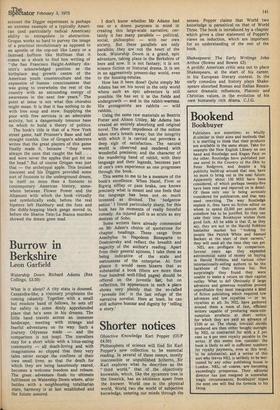Burrow in Berkshire
Leon Garfield
Watership Down Richard Adams (Rex Collings, £3.50) What is it about? A city state is doomed. Cassandra-like, a visionary prophesies the coming calamity. Together with a small but resolute band of fellows, he sets off for safety in some dimly apprehended place that he's seen in his dreams. The little band travels across an immense landscape, meeting with strange and fearful adventures on its way. Such a journey Odysseus made — and the comparison is not inapt. The travellers stay for a short while with a lotus-eating community — all death-loving and with imaginations so clipped that their very tales never escape the confines of their own small lives, so that the death for which they are being luxuriously reared, becomes a welcome freedom and release. The great adventure finds its ultimate fulfilment on Watership Down where, after battles with a neighbouring totalitarian state, harmony is at last established and the future assured. I don't know whether Mr Adams had one or a dozen purposes in mind in creating this large-scale narrative; certainly it has many parallels — political, social, philosophic — with our own society. But these parallels are only parallels; they are not the heart of the book. Watership Down is a grand, epic adventure, taking place in the Berkshire of here and now. It is not fantasy; it is not science fiction or historial drama. It is set in an aggressively present-day world, even to the housing-estates.
How has it been done? Quite simply Mr Adams has set his novel in the only world where such an epic adventure is still possible. He has set it in the fields and undergrowth — and in the rabbit-warrens. His protagonists are rabbits — wild rabbits.
Using the same raw materials as Beatrix Potter and Alison Uttley, Mr Adams has created an entirely absorbing and original novel. The sheer impudence of the notion takes one's breath away; but the integrity with which it is carried out provokes a deep sigh of satisfaction. The natural world is observed and rendered with wonderful precision; and the character of the wandering band of rabbit, with their language and their legends, becomes part of one's own experience as one progresses through the book.
This seems to me to be a measure of the book's excellence. When Hazel, Fiver or Bigwig silflay or pass hraka, one knows precisely what is meant and one feels that the language has been not so much invented as divined. The 'hedgerow patios' I found particularly sharp; for this book has its moments of really forceful comedy. An injured gull is as acute as any denizen of Soho.
Some writers have already commented on Mr Adam's choice of quotations for chapter headings. These range from Aeschylus to Napoleon Bonaparte to Dostoievsky and reflect the breadth and sagacity of the author's reading. Apart from their general aptness, I take them as being indicative of the scale and seriousness of the enterprise. At first glance it would seem bizarre that so substantial a book (there are more than four hundred well-filled pages) should be offered on the juvenile list; but on reflection, its appearance in such a place shows very plainly that the so-called 'juvenile list' is the last refuge of the narrative novelist. Here at least, he can still achieve honour and dignity by 'telling a story.'


































 Previous page
Previous page